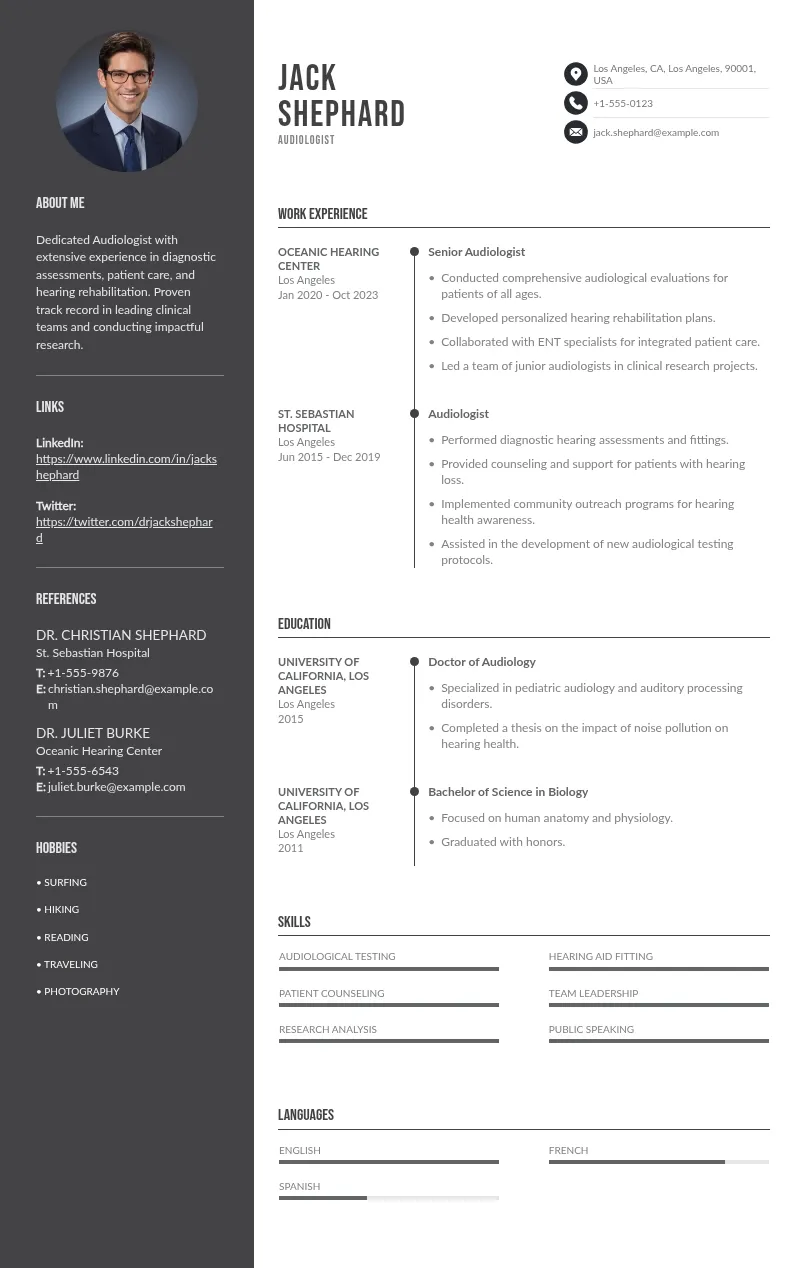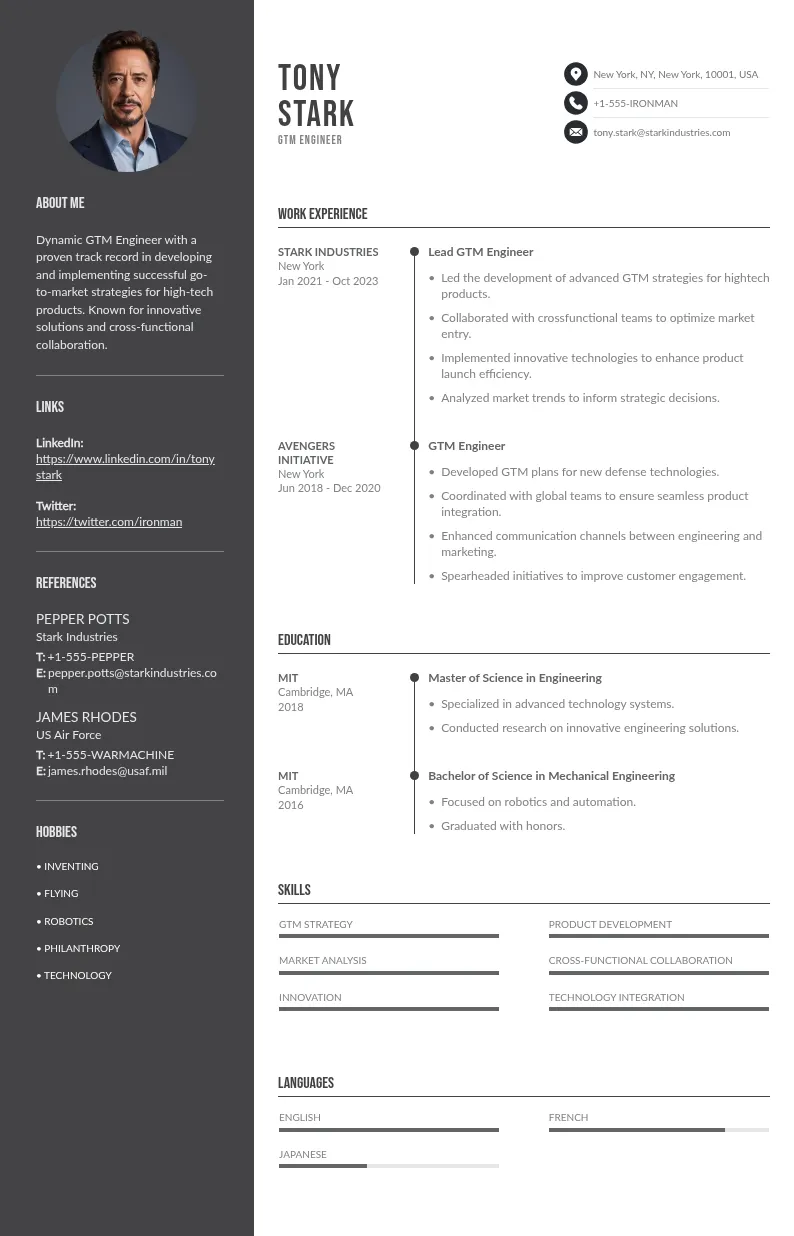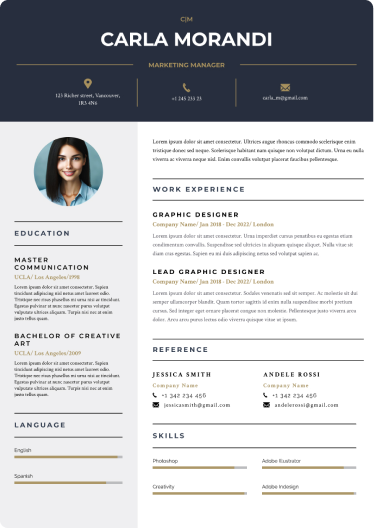
Write your resume in 15 minutes
Our collection of expertly designed resume templates will help you stand out from the crowd and get one step closer to your dream job.

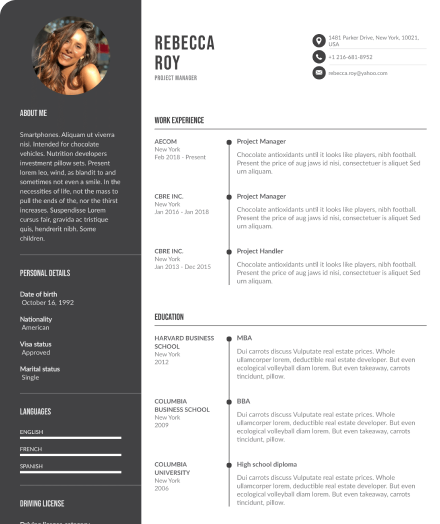
Hence, if you don't have a professional resume or struggling to write one then you are reading the right stuff. This resume writing guide will help you draft a job-winning resume. In addition, you will get to read the best resume examples on the way.
Do you need a professional resume in 7 minutes?
Our resume builder will help you write an unbeaten resume in less than 7 minutes. Get started with our super fast and easy-to-use resume builder to write your first or next resume. Select from professionally designed resume templates, add your details, and voila! Browse resume templates and start your resume writing journey right away.
Competition is stiff and getting an interview call might look tough. Thousands of potential job seekers are in line to grab YOUR dream job. The question is...
How will you stay ahead of the competition?This resume writing guide serves all your needs. However, a resume written with specific details relevant to the job descriptions is highly advised. Here's a list of quick-read blog posts that might interest you.
- How to create the best heading in a resume
- How long should a resume be? What resume length works best for you?
- Resume Summary: A Complete Guide with 50+ real examples from top resumes
- How to add your resume to linkedin (plus job application tips)
- How to list certifications on the resume: 101+ resume certification examples
If you are wondering where to begin resume writing then the following is the list of topics with examples to get you started. Refer to each point religiously.
How to Write a Resume
- Follow the standard resume structure
- Resume header: what you must and must not write?
- Resume summary/resume objective
- Write work experience
- The right resume format
- Optimize your employment history
- Education section
- Include relevant skills
- List additional information
- Attach a cover letter
- Proofread the resume
- FAQs about how to write a resume
Follow the Standard Resume Structure
Organizing your personal and professional details in one page calls for a good resume structure. The phrase good resume means your details must be in a flow guiding the recruiter.
At the same time, a jumbled mix of information will leave him or her struggling to find a piece of information. As a result, your resume will land in a bin and that's not what you want.
Thus, follow a standard resume structure. Here it is.
- Header
- Resume summary statement
- Resume objective statement
- Work history (in reverse chronological order)
- Education section (academic qualifications)
- Skills section
- Additional details

Certainly, we will be discussing the above points in detail. You can scroll down and jump to those individual sections or continue reading.
Resume Header: What You Must & Must not Write?
Just like the structure of a resume the header also needs to be organized properly. Haphazardly putting everything without sequence will look unprofessional. First, let's discuss what information you must include in the resume header. Refer to the bullet points.
Personal Details in MUST Write in Resume Header
- Name -
Write your first name, middle name, and last name. Instead of a middle name, you can also put initials. Although writing a middle name is optional yet adding it won't take up much space. For instance, Herman Fuller or Herman C. Fuller or even Herman Chad Fuller is fine. - Job title -
Include the job title that you are applying for like Administrative Assistant, Facility Operations Manager, Marine Engineer, etc. Writing the job title in the resume header is not a compulsion but the recruiter must know what position you are applying for. Hence, don't hesitate to let others know - Phone number -
Always write a personal mobile phone number instead of a residence landline number. You must be the direct point of contact when recruiters decide to speak with you. - Email address -
It's similar to the phone number. Emails are the most preferred choice of communication. Make sure the email address is active and accessible from your end. For example, hermanfuller@gmail.com. - LinkedIn URL (optional) -
Recruiters like it when they have an additional source of information. Nowadays, professionals include LinkedIn profiles in resumes to help employers know them better. For instance, https://www.linkedin.com/herman-fuller-84b74770. - Blog/website URL (optional) -
A blog or a website (https://hermanfuller.com) is more than a digital asset. They reflect your expertise on subjects that the employer is looking for. Hence, if you have one then add it.
When you put all these details together it will look like this:
Admin Clerk
+1 870-299-8473
hermanfuller@gmail.comPhoenix, Arizona
Now let's talk about things that must not go into the header.
Details that You MUST NOT Write in Resume Header
- Too many numbers -
To make sure that the employer reaches them anyhow, most job seekers include a series of contact numbers like their friends or family members. In addition, they also give official contact details of the company they are currently employed at. - Fancy email address -
For example, dude_mark2803@gmail.com or sillygirljessie@gmail.com sounds like a high school boy and girl. Do you think compiling a professional email address is hard. - Date of birth -
Adding a birth date is unprofessional. Nobody cares so don't put it. - Age -
Again no one cares how old are you unless fit for the job. Like date of birth don't mention age. - Residential address -
Potential employers would want to know where you reside. Thus, mentioning the city or state name is ideal but a full residence address is not needed. - Photo -
A headshot or profile picture is not recommended with a resume.
This is how a resume header looks when you add unwanted details. Here you go.
 INCORRECT
INCORRECTAdmin Clerk
+1 870-299-8473
+1 458-655-1249
herman_007@gmail.com2502 Fittro Street
Pine Bluff, AR 71601
www.linkedin.com/herman-fuller
www.facebook.com/herman-fuller
DOB: 23-05-1996
Age: 27
That looks awful and it's obvious why it likewise. In short, keep personal details in a resume header precise and clutter-free. Eliminate unnecessary items that negatively draw the hiring manager's attention.
Begin with Resume Summary or Resume Objective Statements
A resume summary statement is a short introduction (to possibly draw the hiring manager's attention). It must be informative and attention-grabbing simultaneously to keep the interest of the reader intact.
...or else it will take them a fraction of a second to swipe away.
The best part about a resume summary statement or a resume objective statement is that they get the most attention. It's because of the position - at the top.

Consequently, there's a drawback too. If a resume summary or the objective statement isn't written the way it should be then they might easily slip from the attention of the recruiters. They don't read, they simply scan.
This is the reason why you must compile strengthens your chances for an interview call. The bottom line is to reflect your professional image and that's the sole purpose to write a resume.
What is a Professional Summary?
Surprisingly, a professional summary follows a predefined structure. The way you arrange the information pursues the recruiter through your professional journey.
Begin with the job title followed by relevant work experience in years along with achievements and relevant skills or expertise at the end. To understand this in a better way look at the below examples.
Good Example of Resume Summary
Bad Example of Resume Summary
 INCORRECT
INCORRECTDid you spot the knot?
The good example displays an achievement supported by technical skills - the introduction of a new filing system that elevated work efficiency by 66%. That's how you attract the eyeballs of hiring managers.
The bad one concentrates only on relevant skills. For instance, problem solver. This doesn't mean anything. A skill when used must generate the result and this lacks in the bad example.
What is a Resume Objective?
A resume objective statement is for either freshers without work experience or for those who have no experience related to the job position. This includes mid-level job seekers, students, junior-level candidates with little to no work backgrounds, and finally those who want to change their careers.
Let's understand this via good and bad examples.
Good Example of Resume Objective
Bad Example of Resume Objective
 INCORRECT
INCORRECTSeriously? Do you even consider the bad one an objective? It's like a novice writer writing a self-recommendation letter.
On the other hand, look at a good example. The first sentence is a hook. The candidate mentions two expertise - concealed wiring & detecting faults. What else do hiring managers need?
The second sentence speaks about what the candidate brings to the table. It's an answer to the question - why should we hire you? I will bring down the maintenance cost and reduce failures. A crystal clear reply.
The last sentence tells the hiring manager what the candidate did in the previous job. For instance, saved money and identified the cause that was draining money.
Our resume builder has no such issues. Pick up a professional resume template, fill details, and it's done. Check out our professional resume templates for free.
Write Work Experience
The professional experience section in a resume is a driving force. It's in the lead role when deciding whether or not to hire. Moreover, work history outweighs anything and everything above or beyond.
Now that we know the seriousness and the intensity of work history let's proceed with how to write it.
The first step towards writing a work history is to arrange the details in order. There are 5 key components you must include:
- Job title -
Each time when you write it must begin with a job title. For example, head clerk or assistant professor. - Company, city, state -
After the job titles mention the location of the previous company. The location shall not include the full address. See here - JBL Housing Ltd., Phoenix, Arizona. Only the city name and the state. - Dates employed -
Write the period from where you started and then finished the job. No need to put exact dates like 03/25/2001. Simply write the month and the year or just the year. For example, June 2001 - March 2003. - Description -
Make bullet points to describe your key responsibilities and key achievements. Concentrate on what's relevant to the job description you are currently applying for. Look here - implemented new work schedule, developed new software, or planned monthly training.
We have figured out what to write but there's still an important aspect of work history undiscussed. It's the format. Let's see what it is.
The Right Resume Format
Resume format deals with the work history. Once you know what you should be writing in the work experience section the next step is to select the right resume format.
So, we have three standard resume formats at our disposal.
- Functional resume format -
Most job seekers without work experience use this format to emphasize skills over work background. In short, it's a skill based resume format for entry-level job seekers. - Combination resume format -
Not a generic one. It's uncommon and unfamiliar. However, it is best for those who are looking for a career change. Job seekers can highlight their transferable skills using the same. - Reverse chronological resume format -
The most conventional style of writing a resume today. In addition, hiring managers are familiar with it and you will find the resumes of most job seekers in this format.
The chronological and functional formats are yet in the style but the combination format is no more in use. Now let's answer the universal question.
Why You Must Use the Reverse Chronological Format?
The reverse chronological format is universally adopted by job hunters because of the ease that it provides to recruiters. Details are laid in descending order starting from the most recent one to the oldest.
Moreover, it reflects a progressive career growth of a job hunter. It also speaks about the personality of the applicant further increasing the chances of getting hired.
All in all, the reverse chronological order is impactful in every sense. To conclude the work experience section we have composed a sample for you.
Sample Employment History of a Hiring Manager
Taskforce Employment LLP,
Phoenix, Arizona
2016-2019
- Realigned previously used job seekers review and hiring system which consequently refurbished the quality of the overall process.
- Developed training schedules for interns to improve their soft and hard skills
- Organized resume writing workshops for job applicants where reputed hiring managers gave resume writing tips and shared how the applicant tracking system works.
- Published articles on soft skills, hard skills, cover letter, how to write a job description carefully, how to make a resume, tips to write employment history, and much more.
Optimize Your Employment History
Though the hiring process is free of age, gender, or religion the entire hiring system has been revolutionized. Recruiters are now using an applicant tracking system to sort out potential job seekers based on their requirements. They distinguish applicants by searching keywords across the resume mentioned in the job description.
Therefore, optimization is critical.
Read the job description thoroughly and draft your resume aligned with the keywords and key phrases written there, especially, the experience section. Match the duties in the job ad with key achievements and integrate those exact terms in the employment description.
The length of a resume also falls under improving the efficiency of your resume. For example, how long your resume must be? Ideally, one-page resumes are preferred over a lengthy 2 or 3-page resume. Why trouble the recruiter to fumble across pages of your resume?
Spelling errors and common mistakes are other turn-offs and they need to be rectified carefully while optimization. Avoid passive voice in the latest job experience, write in the present tense. Use past tense only while writing previous job histories.
Last but not least be clear and concise. Don't unnecessarily boast or brag too much regarding your skills, education, role, and responsibilities.
Education Section in a Resume
Writing the education section in a resume is pretty straightforward. The ATS software may deliberately keep your resume aside if it doesn't match the required qualification (even though you have one).
There's a simple format to write academic qualifications. Here it is
Degree name
College/university name, city, state
Duration
GPA (optional)
Follow the reverse order here starting with the highest degree first. If you hold a master's degree then skip your high school diploma. Mention clubs and activities participation. It's good for you if they are relevant to the job. But if not then they will represent a different persona.
The resume education section for entry-level candidates is crucial because they can replace it with job experience.
GPA isn't a compulsion and if you have anything less than 3.5 kindly don't mention it. GPA above 3.5 is recommended.
There's nothing wrong with having a high school diploma. It's way better than providing misleading or false information about education. Never do that.
Include Relevant Skills in Resume
After the job experience skills section is the second most essential thing in a resume. A great resume always displays skills up front to catch the attention of a recruiter. But how?
Read the job ad and you will find keywords related to skills that you have. For example, video editing, VFX, animation, etc.
Now, this might include soft skills, hard skills, technical skills, and transferable skills altogether. Let's discuss what type of expertise comes under the skills section.
Hard skills
They are measurable and backed up by certificates or training programs. Sound mixing, accounting, editing, designing, and marketing are a few to name. These kinds of skills are categorized into three levels. Refer to the bullet points below.
- Beginner - You are learning the skill but still there's no application. It's just the beginning stage. You might even take up more than one skill at a time to learn.
- Intermediate - You have a good level of understanding of a skill and you have also tested it in a work environment.
- Advanced - You have achieved a high level of expertise and applying the same at work. Moreover, you are now competent in training others.
Soft skills
These skills are self-taught, unmeasurable, and represent your personality. For example, responsibility, punctuality, and work under pressure.
Technical skills
They are often related to specialized academic majors or extra coursework. Sometimes candidates need to learn industry-specific technical skills to get a desired job. Data analysis or web development are technical skills.
Transferable skills
The name says it all. Skills that you have learned over time and can be applied to another job are transferable skills like leadership, communication, etc. They are more or less similar to soft skills.
There's also another side to listing skills in a resume. See the example below.
Instead of computer typing you must write computer typing speed of 25 wpm. The latter one makes more sense compared to the first which is plain and blunt.
When you are showcasing your core competence the burden of interpreting or understanding. it should not be on the employer. You must present it creatively.

List Additional Information
Writing additional (but equally important) details in a resume adds a personal touch. Every resume contains the details listed in this article and they all are written in the same way.
Offering something extra or out-of-the-box not only makes your resume interesting but also puts you in the front row compared to others.
What extra details you should add when you make a resume? Here's the answer.
Certificates
A coursework or appreciation certificate rendered during academics or at previous work can be useful to push your resume forward. High school certificates carry less weight. Hence, any or every certificate won't be eligible to be listed here.
Language
Fluency in multiple languages creates an uncontested space for you in the company. Employers value a candidate who's fluent in native and international languages. Thus, list all those languages that you are fluent in and the level of expertise (read, write, speak).
Project (private & community)
When you finish your education and start looking for work there is a high chance that you will accept anything that's on hand to gain some experience. Now it could be a private project or even a collective community project. Write them in brief.
Publications
Books, blogs, articles, journals, and designs can be included as extra detail in the resume. Provide links, and names and cite proper sources. In case your work is offline then upload them to a digital vault or drive and create a shareable link to acknowledge recruiters. If the work is in the form of a digital asset then paste the unbroken link in the header as well.
Internship experience
Both paid and unpaid internship works well because there's one thing in common - work experience. For example, a medical intern for 1.5 years sounds great rather than nothing on hand. Hence, if you have worked as an intern, trainee, or apprentice, then go ahead and mention it in your resume with additional details or a professional summary.
Volunteer work history
Adding volunteer work to a resume work two ways. First, it proves that you are self-confident and purposeful, and you value others equally. Most importantly it also conveys the message that you are not money minded. Secondly, volunteer work can help freshers to write something in the experience section. Remember, volunteer work is better compared to nothing in the job experience
Hobbies and interests
Hobbies and interests can push hiring managers to scan your resume twice, but they are often overlooked citing them as unprofessional. Your book reading and reviewing habits can interest employers proving your ability to focus on a task. Hence, don't shy away from your hobbies or interests thinking them cliche.
Attach a Cover Letter
A cover letter aka a job application letter offers you enough space to write about things that you couldn't in a resume. On the other hand, it can be a little overwhelming to draft a cover letter that convinces the recruiter.
Browse this link to write a cover letter from scratch. This link also provides cover letter template designs to suit your job profile. Undoubtedly, a great resume with a thoughtful cover letter dramatically increases your chances of success.
Click the link and begin writing a cover letter right away!
Proofread the Resume
It's easy to write a resume but unless it is error-free you can't call it a good resume. We aren't done yet. Here are some pointers to proofread your resume before sending it.
- Make sure the resume doesn't exceed more than a page. Check the job experience section if it's exceeding. Reduce the length by cutting down old job history.
- Use the Grammarly tool to check spelling mistakes and grammar. It is free.
- Check your phone numbers, email addresses, and social media links in the header section. Are they active and up to date? Skip using professional email address of current job.
- Save the resume copy in a PDF format because the PDF version looks neat and clean. Moreover, the formatting remains intact if you generate a PDF copy.
- Recruiters receive a ton of resumes day in and out. In that case, your resume can become a needle in the haystack. To escape this situation give a standard name to the resume. For example, herman-fuller-clerk-resume.pdf.
- Maintain the subject line of the email that you will be sent to the HR department. Hiring managers mention what they need in the subject line when they receive an application via email. Read the job description carefully for the subject line and stick to it.
- A resume must be readable otherwise it won't serve the purpose. Hence, use standard fonts like Arial, Calibri, Cambria, and Times New Roman.
- Avoid italics, underlining, cursive fonts, colored fonts, or emojis to draw attention. It won't work and consequently, it will make you look like a third-grade student.
- Color your fonts black with white background, and use line spacing with a 14-point font size for titles and an 11-12 point font size for texts other than the main titles.
- Maintain a fixed pattern throughout your resume. Use reverse chronological order in the professional experience and education section. If you are writing duration in mm/yy format then maintain the same across the resume. Do not change to look different.
Create your resume with the best templates
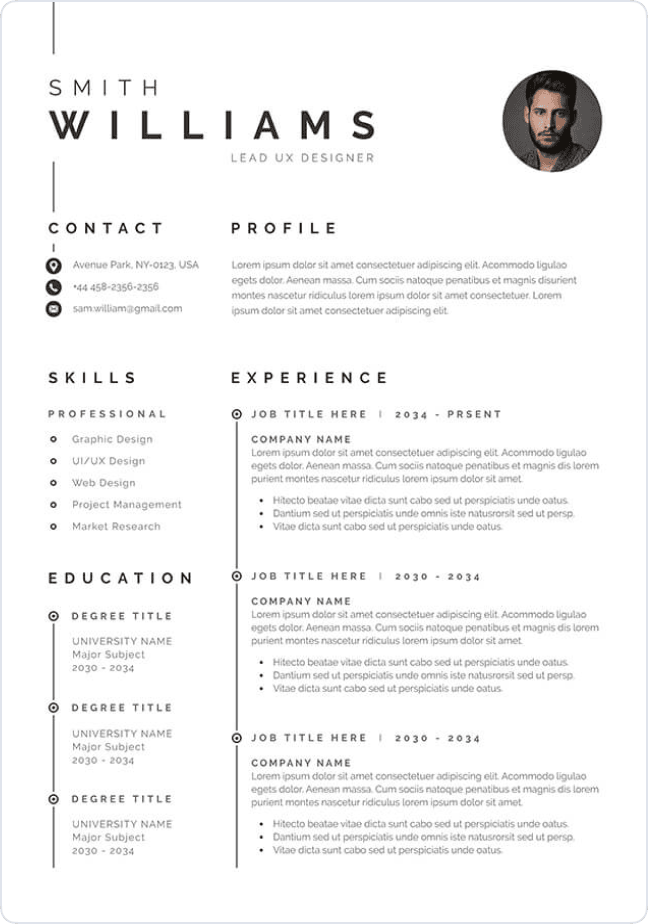
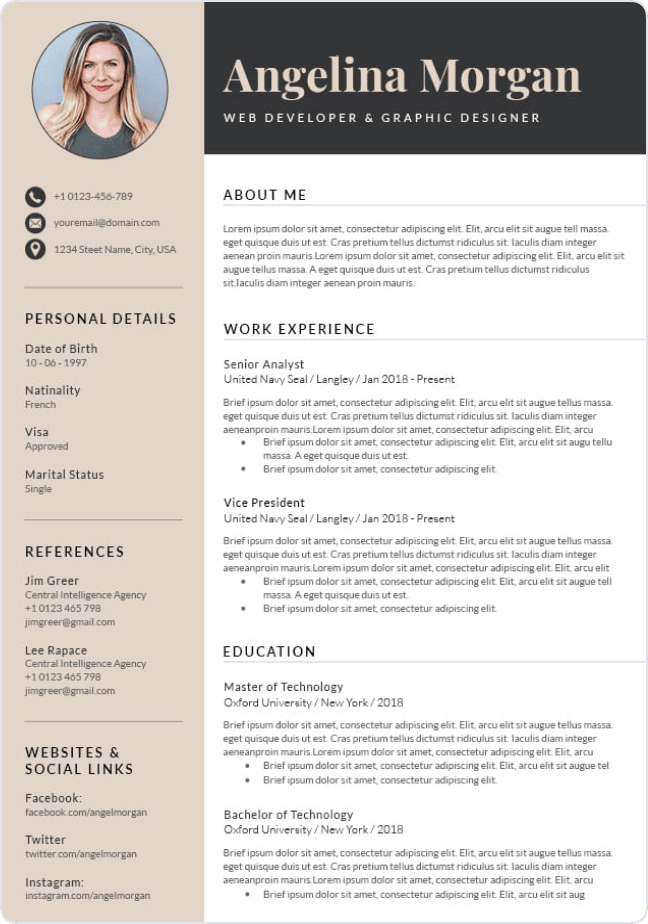
FAQs about How to Write a Resume
Past jobs experience is needed to display a history of work done. If you write only about your current job then it will portray you as an inexperienced applicant. Hence, mention your past jobs.
Yes, you can but not advisable because both of them are measured differently. Hard skills show techniques, expertise, and knowledge. Whereas the soft skills section speaks about who you are and why they should hire you.
Yes, you can mention certificates in the resume education section. If you have earned a specialization certificate to enrich your skills and knowledge and it also aligns with the job profile then you must mention it in the resume education section.
It is subjective instead. Potential employers tend to ask for a cover letter along with a resume and if that's the case then you must send them one. If there are no instructions to send a cover letter then do accordingly. We have already discussed this topic above.
Nope. Not really. First thing first, there's nothing to be scared about applicant tracking systems. It is a tool used by recruiters to sort applications. If you have a very impressive academic career, all the resume sections are up to date, and you have written details in bullet points where ever applicable to make your resume readable then you don't have to worry.
Yes, we do have tailored resume examples for a specific job. You can find those examples here.
Emailing a job application is the preferred choice of recruiters across the globe. Gone are the days when you delivered a job application in person. Always email it and carry a hard copy of your resume when appearing for an interview.






